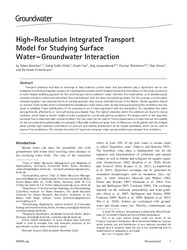High‐Resolution Integrated Transport Model for Studying Surface Water–Groundwater Interaction
Broecker, Tabea
Sobhi Gollo, Vahid
Fox, Aryeh
Nützmann, Gunnar
Arnon, Shai
Hinkelmann, Reinhard
DOI: https://doi.org/10.1111/gwat.13071
Persistent URL: http://resolver.sub.uni-goettingen.de/purl?gldocs-11858/8571
Persistent URL: http://resolver.sub.uni-goettingen.de/purl?gldocs-11858/8571
Broecker, Tabea; Sobhi Gollo, Vahid; Fox, Aryeh; Lewandowski, Jörg; Nützmann, Gunnar; Arnon, Shai; Hinkelmann, Reinhard, 2021: High‐Resolution Integrated Transport Model for Studying Surface Water–Groundwater Interaction. In: Groundwater, DOI: 10.1111/gwat.13071.
 |
Dokument öffnen: |
Transport processes that lead to exchange of mass between surface water and groundwater play a significant role for the ecological functioning of aquatic systems, for hydrological processes and for biogeochemical transformations. In this study, we present a novel integral modeling approach for flow and transport at the sediment–water interface. The model allows us to simultaneously simulate turbulent surface and subsurface flow and transport with the same conceptual approach. For this purpose, a conservative transport equation was implemented to an existing approach that uses an extended version of the Navier–Stokes equations. Based on previous flume studies which investigated the spreading of a dye tracer under neutral, losing and gaining flow conditions the new solver is validated. Tracer distributions of the experiments are in close agreement with the simulations. The simulated flow paths are significantly affected by in‐ and outflowing groundwater flow. The highest velocities within the sediment are found for losing condition, which leads to shorter residence times compared to neutral and gaining conditions. The largest extent of the hyporheic exchange flow is observed under neutral condition. The new solver can be used for further examinations of cases that are not suitable for the conventional coupled models, for example, if Reynolds numbers are larger than 10. Moreover, results gained with the integral solver provide high‐resolution information on pressure and velocity distributions at the rippled streambed, which can be used to improve flow predictions. This includes the extent of hyporheic exchange under varying ambient groundwater flow conditions.
Statistik:
ZugriffsstatistikSammlung:
- Geographie, Hydrologie [454]
This is an open access article under the terms of the Creative Commons Attribution?NonCommercial?NoDerivs License, which permits use and distribution in any medium, provided the original work is properly cited, the use is non?commercial and no modifications or adaptations are made.

